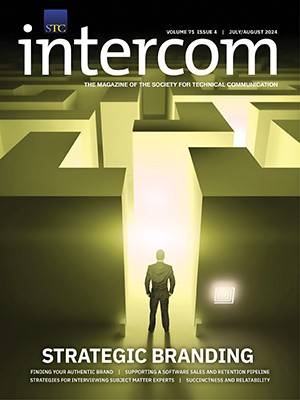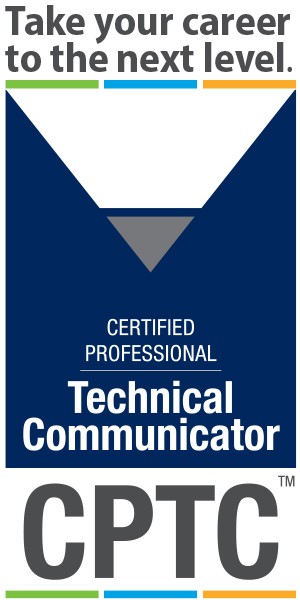By Li-At Rathbun | Senior Member
It’s coming; we all know it’s coming—the day we’ll be asked to help make training videos. And if our company (or client) produces training videos, that day can’t come too soon. Why? Because we’re the writing experts. Because, as with any deliverable, the wording is tighter, clearer, and more organized when we’re involved. As the writing experts, we know how to adjust the message to match the situation.
So let’s all take a collective deep breath and remember: videos are just another channel for doing what we already do best—connecting users with the information they need to successfully complete tasks. Right? No sweat!
Some aspects of creating a training video are more overwhelming than others to those who prefer to remain behind the scenes. For one thing, we may feel uncomfortable at the prospect of having our voices recorded. But helping with videos doesn’t necessarily mean we’ll be the "on-air talent." It seems that for every tech writer who wants to run as far away from the microphone as possible, there are several SMEs (subject-matter experts) who are eager for an opportunity at stardom via the company training video. So don’t get hung up on this point.
Our greatest contribution is in creating the script. We may also be involved with generating screen captures (also known as screencasts), recording or cleaning up audio, and even making the training video itself. But, at a minimum, we should participate in the scriptwriting process.
Data Gathering
Your data-gathering process will vary depending on the sort of SME you have at your disposal. You might conduct a traditional SME interview or gather information from the product documentation. Or perhaps you’ll use a hybrid of these. If you have access to the product trainer, it might make sense to record a training session as background material. That way, you can capture the training flow and nuances of how to perform the tasks.
Scriptwriting
No matter how you collect your source information, the video content and video creation will flow most smoothly if there’s a script. We can shy away from recording the audio, respectfully declining the limelight, but the script is our domain. (If your company produces videos but does not ask for your help, you may need to remind them of your expertise.)
Script Format
You can write your script in whatever format works for you, particularly if you’ll be the one recording the audio. But it’s a good idea to create a video-script style guide and a template. This will establish a consistent format and process, which will enhance uniformity across video projects as well as facilitate communication with SMEs, script approvers, and anyone else involved. The style guide is simply a legend, where you designate different colors for different aspects of your script—such as draft comments, questions for the reviewer, and actions that coincide with the script (see Figure 1). Of course, by the time you have a final script, the draft comments and questions will be resolved.
Transcript
Some projects include a transcript next to the video, for users who must rely on the written word or use it to enhance their comprehension. If your project will include a transcript, you can strip out internal comments, or even add elements to it. For example, in a training video, I may say, "Tom Johnson shares some great scriptwriting tips in his blog." I would not need to say the URL for the blog because viewers could see within the video the blog that I refer to. But if I published the transcript, I would add the URL there. So I would include this color-coded note in the script: (include just in the transcript: http://idratherbewriting.com/category/video-tutorials/).
Step 5 in Figure 1 shows what the script looks like for this video segment. The light blue font in italics is the action on the screen; the pink font is the URL note for the transcript. Figure 2 shows what this same step looks like in the transcript. All that appears in the transcript is the narration from step 5, plus the URL from the pink note.


Example of Message Shifting to Adjust to the Medium: Procedures Guide vs. Script
The main thing for us , as the writing experts, to remember is that scriptwriting is not a new, foreign skill. We are simply adjusting the message to the medium—which, in this case, may be new.
Figures 3 and 4 serve as examples of what the same message to the same audience might look like in two media—one read, the other watched and listened to. Both figures lead to a procedure for creating Google Sheets by converting an existing spreadsheet. The information is the same, but the way the user will encounter and receive the information varies.


Ready, Set, Write!
Now that we’ve established that video scripts are just another writing assignment, and that we are the ones to write them, here are some basic things to think about when creating the script:
- Video Length: The ideal video length is around three minutes; two minutes is great and four minutes is okay. You’ll likely lose the viewer if you go much longer than that. If you need to cover a lot of information, parse it into a series of videos.
- Words-to-Video Length Ratio: One minute of video is equal to about 100 words. This is a good reminder for SMEs who want to include too many details in the script, and a good argument for why a script is needed in the first place (so that we can succinctly say just what we mean).
- Meaning through Movement: The action on the screen will help replace some of the words needed when describing a static graphic. So you can get a lot of detail into 100 words.
- Tone: The wording should be conversational but still professional. As with any professional messaging, avoid condescension and being too informal.
Conclusion: Why Writers Matter in Training-Video Projects
There will be times when the video project proceeds without us. After all, "Anyone can write." Right? We’ve heard this before. Now we face a medium that, for many of us and those we work with, constitutes a new frontier.
But the company’s professionalism is at stake, and it may not take long for viewers to notice our absence. Whether it’s a "copywrite page" instead of a "copyright page," or the confusion viewers feel when the narrator switches between "you," "we," and "the user" within the same paragraph, or the unease viewers feel when the narrator gushes, "Wow! Wasn’t that a cinch?"—sooner or later, we’ll be missed.
So whose lines are these, anyway? If the aim is to deliver information in a clear, competent, and relatable way—the kind that makes the company (or client) look good—those lines are ours. Others can have the limelight, but we’re the ones who can make them shine brightest!
Li-At (Ruttenberg) Rathbun participated in eLearning back when it was called CBT (computer-based training). Although her current role at Yardi Systems is as technical editor, she’s busy these days with initial-implementation training videos—a series that steps new clients through setup tasks that they can complete on their own, sparing them from hours on the phone with tech support. You can connect with Li-At on LinkedIn, Twitter (@virtual_li), or email (stc.liat@gmail.com).



Good morning, Ms. Rathbun:
Thanks for your article in Intercom re script writing. Please accept my comments as “constructive.” The universal communication problem with information motion-media shows (video) scripts is that they are written. Motion media is not a written-word medium or a listening medium. It is a kinetic visual medium. That is the vast majority of the information ought to be in the kinetic visuals and not in the audio. Psychological studies by Hoban and Van Ormer at Pennsylvania State University discovered that maximum communications occurs in information motion-media when about 70% of the information is encoded in relevant kinetic visuals, and no more than 30% of the information is in the narration. (The exception is in the slice-of-life scenarios that focuses on sociological themes: sexual harassment, alcoholism, eg.) The narration (the spoken word) must be used only when the script designer (ergo, script writer)cannot encode all the information in the kinetic visuals and the audience must know that information–that is, the information that they need for a complete understanding cannot be encoded in the kinetic visuals. Such narration must be in absolute coherence with the kinetic visuals–that is they reinforce each other. A glaring misuse of the above dicta are the prescription drug TV commercials–the narrator babbles about the danger of the ACME nose-ward removal nostrum while the kinetic visuals wander aimlessly with irrelevant scenes. The communication failure in such shows is that the information the audience needs to know is in the audio and not in the primary communication medium–the kinetic visuals.
Should you want to garner more information re this kinetic visual communication topic, may I suggest that you read by book titled “Communication Ideas with Film, Video,and Multimedia.” My book earned the Best of Show award in one of STC’s competitions a few years ago. It is available on Amazon Kindle, from Southern Illinois University Press, and from me (sheltoncomm@suddenlink.net).
My credentials for these comments and authorship of my award-wining book: I earned my Master of Arts degree from the University of Southern California, Cinema Department where I focused my studies on the psychology of information film and communication theory. I’m now retired. During the forty-years in my professional career in information motion-media production. I garnered over forty awards in national and international motion-media competitions and festivals. I am a Fellow of STC and earned the President’s Award. For some thirteen years I started and managed STC’s audiovisual/video competition (now, unfortunately, defunct.) I hosted some fifteen all-day workshops re motion-media communications at our annual conferences. And about a dozen more at regional conferences. [The worst comment I received on the written evaluation was, “Marty does not know what he’s talking about.” The best comment was, “I learned more in the first hour of Marty’s workshop than I have in three-days at this conference. (in those days, the workshops were at the end of the conference.)]
Unfortunately, nowadays, STC’s management and membership are more focused on the written word rather than on the primary communication media of the day–motion media (film, video, multimedia).
Hi, Marty.
Thank you for reading my article and responding. My apologies for only now looking at this online page and so seeing your message only now ((I have the PDF version; so I read the articles there).
I agree with you: the narration must support the kinetic message. I think the scripts and videos I create adhere to what you’re proposing. And I know that they do not follow the prescription drugs model from TV commercials.
The primary aim of this article was to introduce technical communicators that have no experience in creating videos to some of the basic concepts, and to provide them with a tool: the script. I think if you and they look at the example of narration in the right column with what the corresponding kinetic message from the left column will look like, you’ll see it matches what you’re advocating. The narration mimics and enhances what’s occurring on the screen.
Thanks for reinforcing this notion with your comments and research citation.
Thank you, too, for your years of service to STC and the profession!
(We met in the LASTC chapter years ago.)
Regards,
Li-At